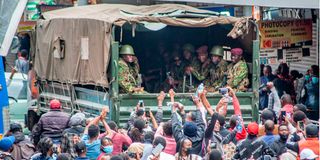Premium
Gen Z protests: A revolution aided by technology

Anti-Finance Bill protesters mob a police lorry during demonstrations on the streets of Nairobi on June 20, 2024.
In what is being called a historic movement, Kenya is currently witnessing one of the largest and most unusual protests in recent memory.
At the root of the unrest is the 2024 Finance Bill, in which the government seeks to raise an additional $2.5 billion (Sh323 billion) through increased taxes from the next financial year in July.
The move has sparked widespread outrage among Kenya's youth, especially Generation Z, who are now taking to the streets to voice their discontent.
On June 25, nationwide protests under the banners 'Occupy Parliament' and 'Reject Finance Bill' continued for a third day. Demonstrations took place in over 25 counties across the country, with some protesters even entering the heavily secured parliament building.
What sets these demonstrations apart is their meticulous organisation through social media channels, a tactic that has effectively mobilised thousands of passionate protesters.
Key among these digital platforms is Zello, an app that facilitates real-time communication, allowing most of them to coordinate, share protest updates and even connect with emergency services.
To join the movement, people simply download the Zello app, go to the Channels tab and scan the QR code provided to access the #RejectFinanceBill2024 channel.
Read also: Ruto: This was treason
Waringa Njehia, a content creator, praised the app for its role in informing others about the whereabouts of police and areas of potential danger.
"In Zello, you choose about five people to give instructions to. Their voices have to be very familiar. It's like a walkie-talkie. They join the app and update each other on safe areas. The cohesiveness of Gen Z is incredible and this revolution is greatly aided by technology," says Njehia.
Another protester, who goes by the street moniker ItsMoran, points out that many of these applications do not require you to share your phone number once you have signed up.
"Zello, for example, already has a Reject Finance Bill 2024 group where people are constantly sharing police locations. You can also use the app to chat with your family. Zello differs from traditional walkie-talkies by allowing you to connect with strangers on open channels."
In addition, Manu shared that WhatsApp became the main platform, with over 50 groups created to discuss the revolution and coordinate meeting points.
Another tool used during the demonstrations is Briar, a messaging app tailored for activists, journalists and anyone who needs a secure and reliable communication platform.
Another protester, identified only as Phil, described Briar as one of the best, despite its slowness.
"I deleted it, but it was effective because you don't need data bundles to use it," he noted.
To broaden their outreach, the young activists have also used social platforms to explain the nuances of the Finance Bill in different local languages, distributing informative videos via WeTransfer.
Gen Zs are also using platforms such as Facebook Live and X Space Live to broadcast live footage of demonstrations. This helped to reach a wider audience in real-time.
Their focus remains on essential safety items to protect themselves from the effects of tear gas.
They've devised various methods to alleviate the discomfort caused by the powerful tear gas, including the use of toothpaste, milk, lemon, masks, goggles, water and Kenyan flag-emblazoned handkerchiefs.





